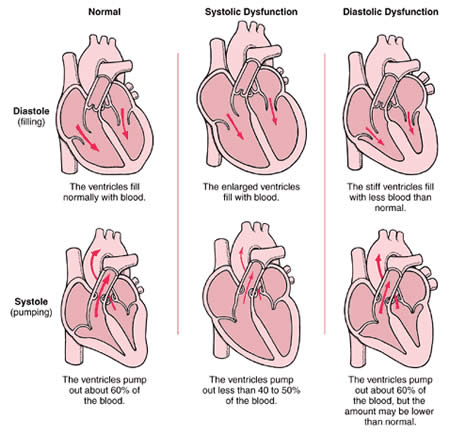Difference between Systolic Dysfunction and Diastolic Dysfunction
Key Difference: In systolic dysfunction the heart is fails to pump blood. Simply, the heart is not able to pump with the pressure it used to. Diastolic dysfunction is when the ventricle fails to adequately relax and becomes stiff. This causes the ventricle to fill inadequately and the pressure of the blood to decrease.
Systolic dysfunction and diastolic dysfunction are two different types of heart failure. These are two different ways the heart can stop pumping blood to the rest of the organs. The medical lingo often makes it difficult to understand the differences between two different types of medical conditions or two different names for the same condition. Heart failure or congestive heart failure is a medical condition when the heart is unable to pump effectively to provide blood to the rest of the heart.
 Heart failure is a condition when the heart is unable to provide a sufficient pump action to maintain the blood flow, dropping the pressure by which the blood moves through the body. Heart failure is also known as congestive heart failure (CHF) or congestive cardiac failure (CCF). In layman’s terms, the heart has become weaker and is not able to pump with the same power as it was able to before. As it the heart pumps blood slower, the blood moves slower throughout the whole body. This causes the blood tissue to suffer ischemia, or thinning of the blood. This may cause the heart chambers to stretch to hold more blood or become stiff and thickened. The weakening of the heart pressure causes the kidneys to retain water and salt, causing fluid to build up in the arms, legs, ankles and feet.
Heart failure is a condition when the heart is unable to provide a sufficient pump action to maintain the blood flow, dropping the pressure by which the blood moves through the body. Heart failure is also known as congestive heart failure (CHF) or congestive cardiac failure (CCF). In layman’s terms, the heart has become weaker and is not able to pump with the same power as it was able to before. As it the heart pumps blood slower, the blood moves slower throughout the whole body. This causes the blood tissue to suffer ischemia, or thinning of the blood. This may cause the heart chambers to stretch to hold more blood or become stiff and thickened. The weakening of the heart pressure causes the kidneys to retain water and salt, causing fluid to build up in the arms, legs, ankles and feet.
Heart failure is actually a wrong term to describe the condition as it does not consist of the heart stopping completely. In a heart failure, the pressure by which the heart pumps blood throughout the body reduces as the heart weakens. The weakening pressure reduces the speed with which the blood flows through the body, causing many tissues and organs to not receive properly oxygenated blood. The reduction in oxygenated blood causes the kidneys to retain fluids, which causes swelling in the lower body. Heart failures are often onset by heart attacks, coronary artery diseases, high blood pressure, valve diseases, etc. Depending on the symptoms, heart failure can affect the left side ventricle or the right side ventricle. The left-side failure can cause the heart to become enlarged and overlaps with the right-side failure. The left-side failure can cause the right-side ventricle to fail as well. The right-side failure is more commonly associated with the retention of fluids and swelling underneath the skin.
Systolic dysfunction is the more common type of heart failure is much easier to diagnose. In systolic dysfunction the heart is fails to pump blood. Simply, the heart is not able to pump with the pressure it used to. It only operates on 45% of the original pump function. Losing the strength of the pump function, results in an inadequate cardiac output. This type of heart failure is caused by diseases or pharmacological agents (includes drugs). The heart muscles are damaged by ischemia that causes infarction and scar formation. Because of the loss of pressure the left ventricle is unable to empty adequately, resulting in increased pressure and volume. This causes pulmonary edema (filling of fluid) in left heart failure and peripheral edema (swelling) in right heart failure.
Diastolic dysfunction is when the ventricle fails to adequately relax and becomes stiff. This causes the ventricle to fill inadequately and the pressure of the blood to decrease. The stiff ventricle increase pressure and has similar results to the systolic dysfunction. The increased pressure results in pulmonary edema and peripheral edema. Diastolic dysfunction can be caused by similar circumstances as those of systolic dysfunction. Diastolic dysfunction will not manifest if the systolic dysfunction is persevered. There may be no symptoms when the patient is at rest, while the patient becomes extremely sensitive to increase in heart rate and sudden bouts of tachycardia. Left ventricular diastolic function can be diagnosed using echocardiography and my measuring ration, ventricular filling, deceleration time, and the isovolumic relaxation time.
Image Courtesy: med.uc.edu









Add new comment